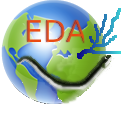| Version 1 (modified by celine, 15 years ago) (diff) |
|---|
back to first page ..
Summary text description of the dataset
EDA model presently runs with BD_Carthage® v3, a spatial referencing system for surface water in France and will be tested on two European hydrographical databases, CCM v2.1 (Catchment Characterisation and Modelling) (Vogt et al. 2007) and Ecrins (European Catchment and RIvers Network System).
BD_Carthage
The BD_carthage®v3 is a spatial referencing system of surface water environments in France. It’s based on the BDCarto database of the French National Geographic Institute (IGN). BDCarthage completes BDCarto with hydrographic coding information representing water courses, water tracts and wetlands.
CCM
The CCM (Catchment Characterisation and Modelling) River and Catchment Database (version 2.1, CCM2) covered the entire European continent. It includes a hierarchical set of river segments and catchments based on the Strahler order, a lake layer and structured hydrological feature codes based on the Pfafstetter system. The CCM covers an area about 12000000 square kilometres and includes more than 2000000 primary catchments. It’s includes a coastline and some 70000 lakes.
It’s a fully connected and hierarchical network of rivers with flow directions.
Data processing is performed in the LAEA projection (Lambert Azimuthal Equal Area) with the ETRS 1989 datum.
ECRINS
The ECRINs layers (European Rivers and Catchments)
Presence/absence and densities
The presence/absence and densities of yellow eel in France are obtained from the Aquatic environment and fish database (BDMAP - more than 11 787 fishing samples used, collected on 6 007 sampling stations) from the French National Office of Water and the Aquatic Environments (ONEMA) and other databases from the Brittany watershed.
The current time horizon of the database is 1977 to 2008. Different prospecting methods (with different targets) of electrofishing are used.
Values of the explanatory variables are calculated for each segment of the river network on the CCM layer.
Distance to the sea
The distance to the sea (comes from the CCM layer) and the relative distance (between sea limit and the more upstream source) are directly calculated from the river network topology.
Temperatures
The temperatures are extracted from the CRU (Mitchell et al., 2004) and Worlclim (www.worldclim.org).
Elevation and slope
Elevation and slope are extracted from the National Height Elevation Database (BD ALTI® - spatial resolution of 50m) from the National Geographic Institute.
ROE –Obstacle pressure
The obstacle pressure (characteristics, Steinbach's expertise score…) comes from the National list of obstacles to river flows (ROE) from the ONEMA.
Fisheries data set
Glass eel fisheries data set comes from Castelnaud (1994), non-professional/leisure fisheries and professional fisheries data set from the ONEMA.
Water quality
The data sets used to extract the water quality parameters are obtained from the RNABE database (/ROM database of ONEMA?).
CORINE Land Cover
Corine Land Cover (CLC) is a database on soil occupation in 32 european country and provides general habitat information. The CLC Map of France is a pan-European product showing 44 land cover types of the 3-level Corine nomenclature at a minimum mappable unit of 25 ha and a minimum feature width of 100 m(for linear features). The CLC map is provided in vector format and is designed specifically to be viewed and used at a 1:10000 scale or a 1:25000. Data are available at 250/100 meters resolution and categorized using the 44 classes. Land cover class 523 Sea and ocean (GRID_CODE 44 in the raster data): in order to provide consistency with earlier releases of CLC data, category 523 has been masked in the raster data.
